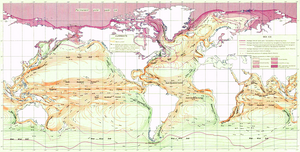North Atlantic Current: Difference between revisions
m Reverted edits by 64.8.149.4 (talk) to last revision by Zad68 (HG) |
|||
| Line 4: | Line 4: | ||
The '''North Atlantic Current''' (also known as '''North Atlantic Drift''' and '''North Atlantic Sea Movement''') is a powerful warm [[ocean current]] that continues the [[Gulf Stream]] northeast. West of [[Continental Europe]] it splits into two major branches. One branch goes southeast, later to become the [[Canary Current]] as it passes northwest [[Africa]] and turns southwest. The other major branch continues north along the coast of [[northwestern Europe]]. It is thought to have a considerable warming influence on the [[climate]], although a minority have disputed this.<ref>{{cite web|author=R. SEAGER, D. S. BATTISTI, J. YIN, N. GORDON, N. NAIK, A. C. CLEMENT, and M. A. CANE|title=Is the Gulf Stream responsible for Europe’s mild winters?|year=2002|publisher=Quarterly Journal of the Royal Meteorological Society|accessdate=2010-10-25|url=http://www.ldeo.columbia.edu/res/div/ocp/gs/pubs/Seager_etal_QJ_2002.pdf}}</ref> Other branches include the [[Irminger Current]] and the [[Norwegian Current]]. Driven by the global [[thermohaline circulation]] (THC), the North Atlantic Current is also often considered{{by whom|date=May 2011}} part of the wind-driven Gulf Stream which goes further east and north from the [[North America]]n coast, across the [[Atlantic]] and into the [[Arctic Ocean]]. |
The '''North Atlantic Current''' (also known as '''North Atlantic Drift''' and '''North Atlantic Sea Movement''') is a powerful warm [[ocean current]] that continues the [[Gulf Stream]] northeast. West of [[Continental Europe]] it splits into two major branches. One branch goes southeast, later to become the [[Canary Current]] as it passes northwest [[Africa]] and turns southwest. The other major branch continues north along the coast of [[northwestern Europe]]. It is thought to have a considerable warming influence on the [[climate]], although a minority have disputed this.<ref>{{cite web|author=R. SEAGER, D. S. BATTISTI, J. YIN, N. GORDON, N. NAIK, A. C. CLEMENT, and M. A. CANE|title=Is the Gulf Stream responsible for Europe’s mild winters?|year=2002|publisher=Quarterly Journal of the Royal Meteorological Society|accessdate=2010-10-25|url=http://www.ldeo.columbia.edu/res/div/ocp/gs/pubs/Seager_etal_QJ_2002.pdf}}</ref> Other branches include the [[Irminger Current]] and the [[Norwegian Current]]. Driven by the global [[thermohaline circulation]] (THC), the North Atlantic Current is also often considered{{by whom|date=May 2011}} part of the wind-driven Gulf Stream which goes further east and north from the [[North America]]n coast, across the [[Atlantic]] and into the [[Arctic Ocean]]. |
||
== See also == |
gserujytjrty== See also == |
||
* [[Ocean current]] |
* [[Ocean current]] |
||
* [[Oceanic gyres]] |
* [[Oceanic gyres]] |
||
Revision as of 18:28, 24 May 2013

The North Atlantic Current (also known as North Atlantic Drift and North Atlantic Sea Movement) is a powerful warm ocean current that continues the Gulf Stream northeast. West of Continental Europe it splits into two major branches. One branch goes southeast, later to become the Canary Current as it passes northwest Africa and turns southwest. The other major branch continues north along the coast of northwestern Europe. It is thought to have a considerable warming influence on the climate, although a minority have disputed this.[1] Other branches include the Irminger Current and the Norwegian Current. Driven by the global thermohaline circulation (THC), the North Atlantic Current is also often considered[by whom?] part of the wind-driven Gulf Stream which goes further east and north from the North American coast, across the Atlantic and into the Arctic Ocean.
gserujytjrty== See also ==
References
- ^ R. SEAGER, D. S. BATTISTI, J. YIN, N. GORDON, N. NAIK, A. C. CLEMENT, and M. A. CANE (2002). "Is the Gulf Stream responsible for Europe's mild winters?" (PDF). Quarterly Journal of the Royal Meteorological Society. Retrieved 2010-10-25.
{{cite web}}: CS1 maint: multiple names: authors list (link)
External links
- The North Atlantic Current. Elizabeth Rowe, Arthur J. Mariano, Edward H. Ryan, The Cooperative Institute for Marine and Atmospheric Studies
